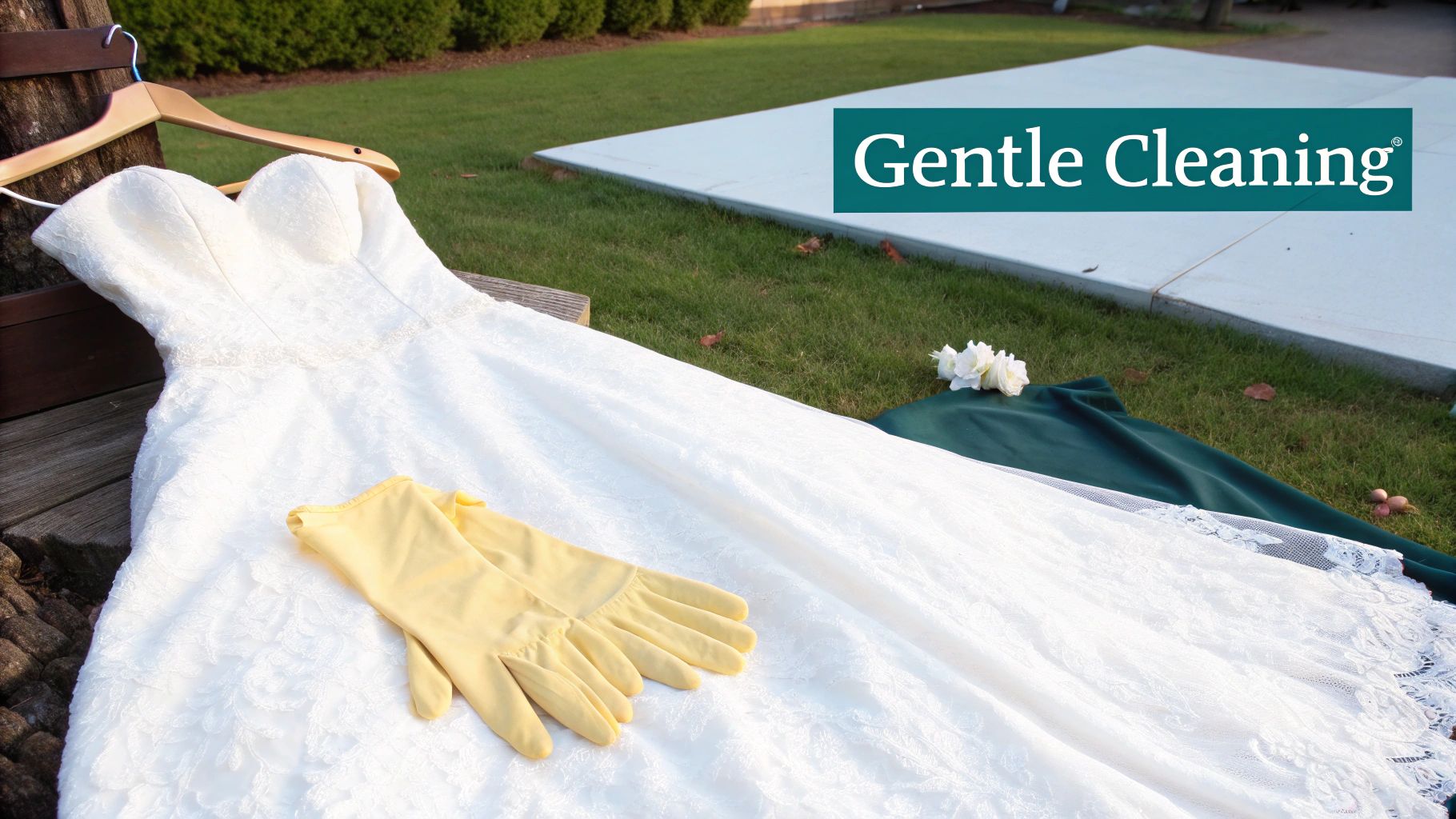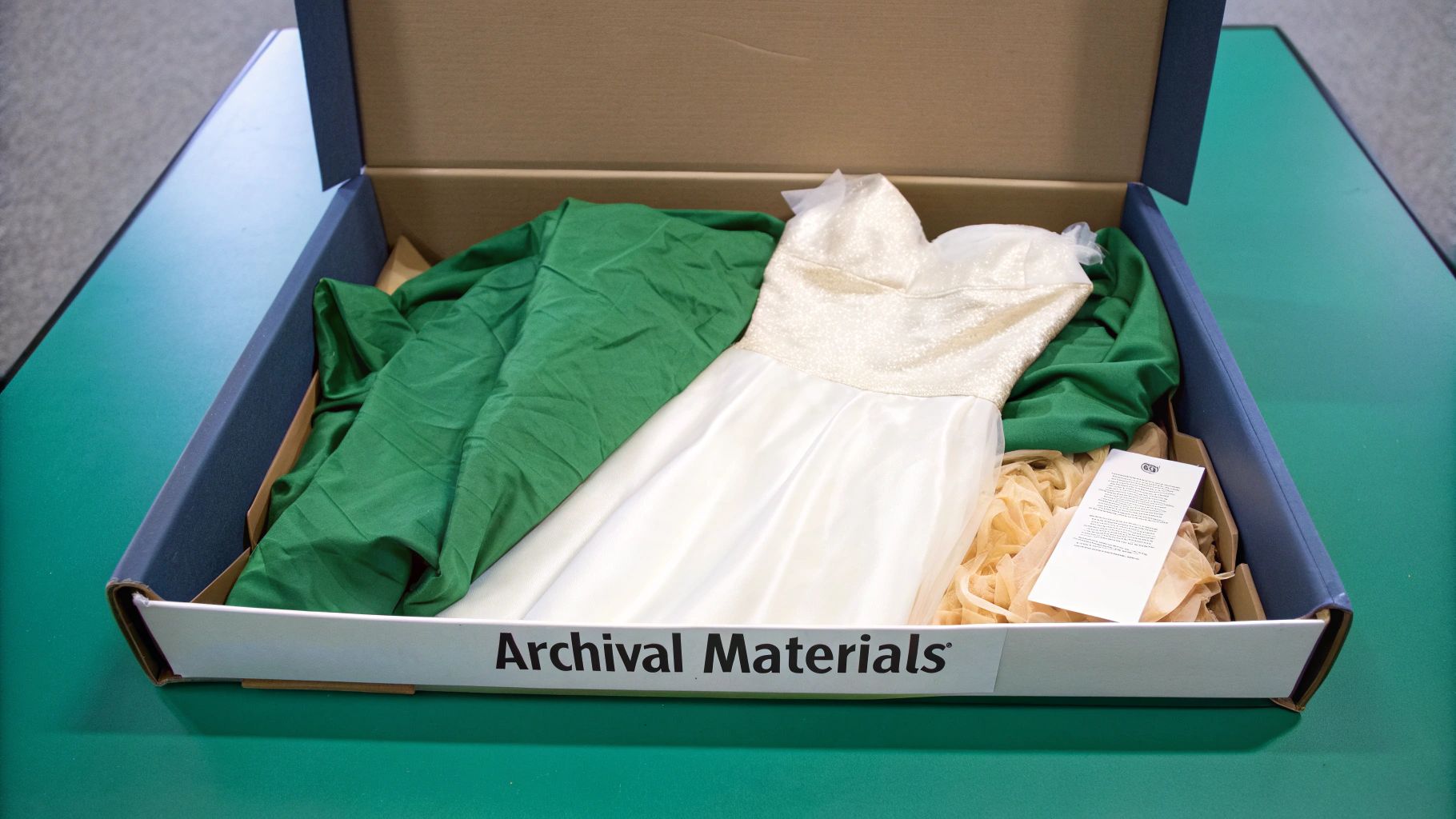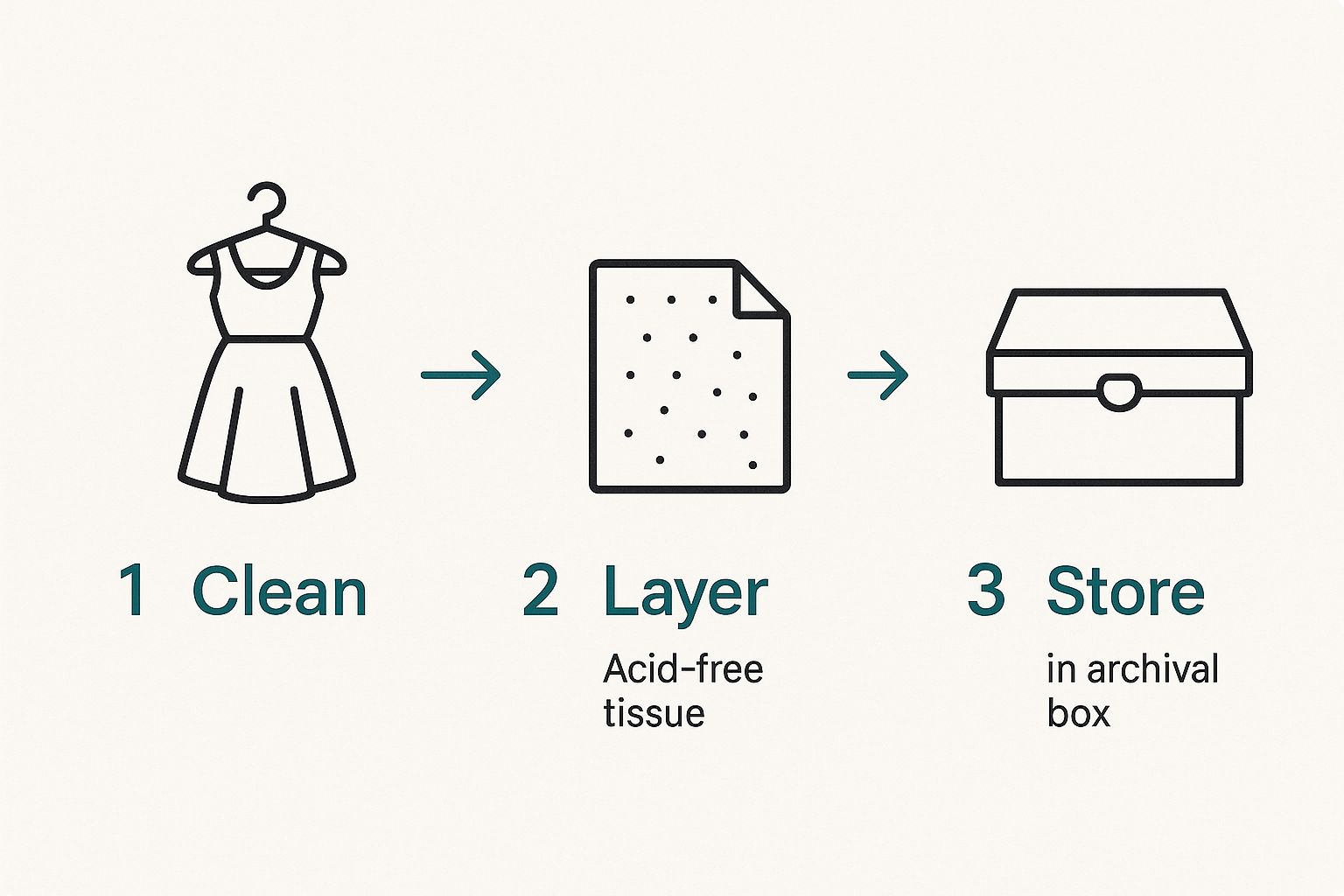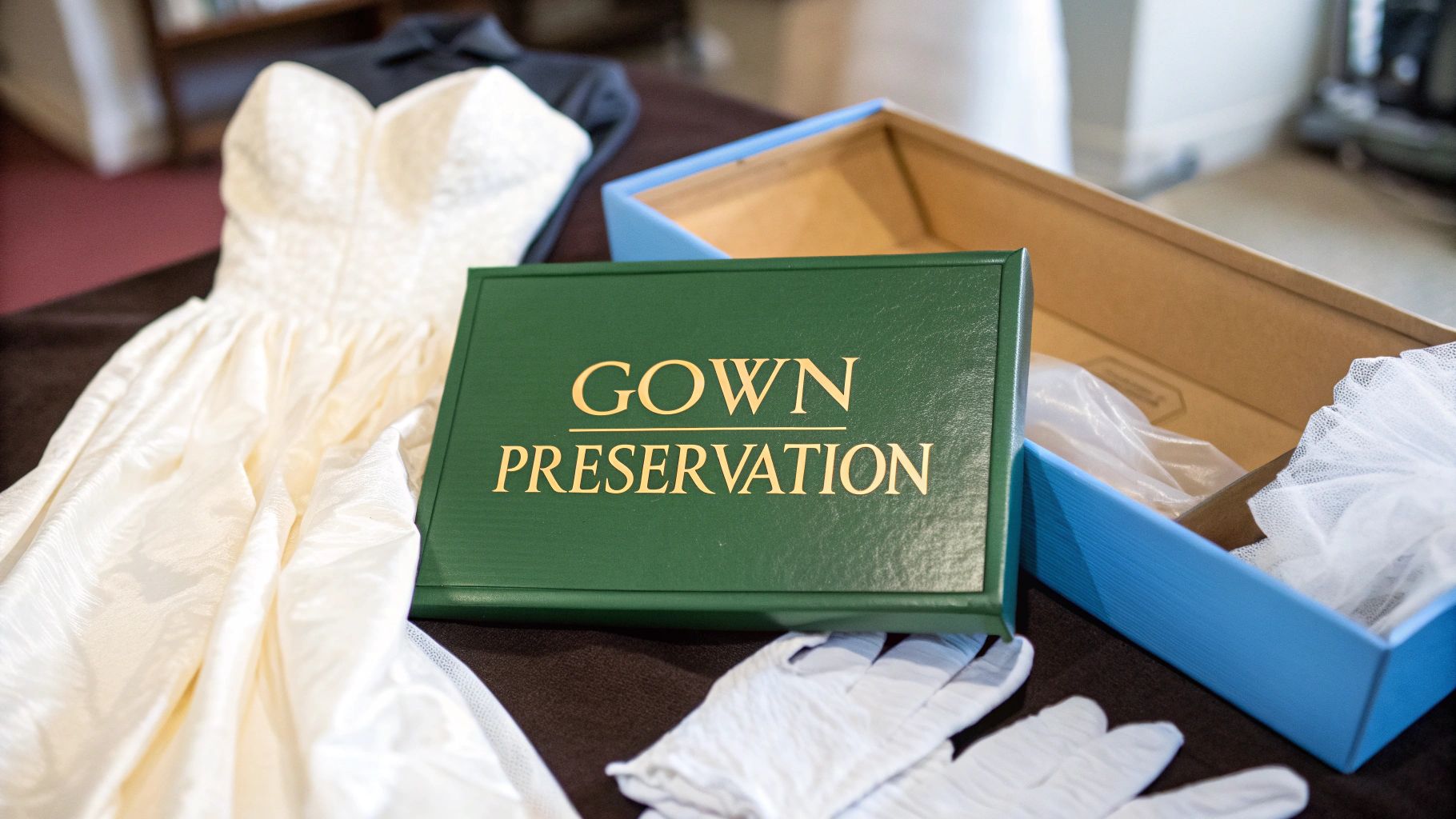Getting your wedding dress stored properly isn't a one-and-done task—it's a three-part mission. It starts with professional cleaning by a specialist, moves on to careful packing with acid-free materials, and finishes with storage in a climate-controlled spot. If you cut corners on any of these, you're risking yellowing, fabric decay, and damage that you just can't undo.
Preserving Your Wedding Dress for Decades
That dress isn't just a dress. It's a collection of memories from one of the most important days of your life. To make sure it stays a beautiful keepsake for years—or even decades—you need a real preservation strategy. Tossing it in the back of a closet is one of the biggest mistakes you can make.
The whole point is to shield the gown from its natural enemies: light, humidity, temperature swings, and acidic materials. Each one of these can break down the delicate fibers in silk, satin, and lace, leaving them discolored and brittle.
The Foundation of Proper Storage
Believe it or not, successful preservation begins the moment the wedding is over. The very first step should be getting the dress professionally cleaned. Invisible stains from champagne, sweat, or a smudge of cake frosting are like little time bombs. If you leave them, they'll oxidize over time and turn into stubborn yellow or brown spots that are next to impossible to get out.
Once it's spotless, how you pack it is critical. The absolute gold standard for textile preservation is using acid-free tissue paper inside an archival-quality box. Your average cardboard box and regular tissue paper are loaded with acid that will literally leach into the fabric, causing it to yellow and weaken.
Key Takeaway: Preservation is an active process, not a passive one. It’s a specific set of actions designed to combat the natural aging process of delicate fabrics, ensuring your gown remains an heirloom rather than a cautionary tale.
Why Your Storage Environment Matters Most
The final piece of the puzzle—and maybe the most important—is where you store the dress. The absolute worst places are usually the most convenient: attics and basements. These spots are notorious for wild temperature swings and high humidity, which is the perfect recipe for mildew and fabric rot.
Instead, you need a stable, climate-controlled space. A closet in the main part of your house or the space under your bed are great choices because they stay dark, dry, and maintain a pretty consistent temperature. For a deeper dive into why stability is so crucial, check out our detailed guide on the benefits of climate-controlled storage.
Wedding Dress Storage At a Glance
Feeling a little overwhelmed? It's really about sticking to a few key principles. Here’s a quick-glance table to help you keep the DOs and DON'Ts straight.
Ultimately, a little care now goes a long way. Following these best practices ensures your dress will look just as stunning decades from now as it did on your wedding day.
Why Professional Cleaning Is a Non-Negotiable First Step

Before you even think about boxes or tissue paper, the first real step in preserving your wedding dress is getting it professionally cleaned. I can't stress this enough—it's the most critical part of the entire process. The biggest long-term threats to your gown aren't dust or moths; they're the stains you can't even see.
Things like a splash of champagne, a bit of frosting from the cake, or even just sweat might seem harmless now. But over time, these sugar-based stains oxidize. It’s a slow chemical reaction that causes them to turn into stubborn, ugly yellow or brown spots that are nearly impossible to remove down the line.
Why Your Local Dry Cleaner Probably Isn't the Answer
Taking a gown with delicate beading, lace, or silk to a standard dry cleaner can be a huge gamble. Most local shops use a one-size-fits-all approach, running your dress through the same machines and solvents they use for everyday suits. This just doesn't work for the unique needs of a wedding dress.
For example, many cleaners reuse their chemical solvents to save money. This means impurities from other clothes can get redeposited right onto your dress, leaving behind a weird smell or filmy residue. A real wedding gown specialist does things differently. They use virgin solvent—a pure, brand-new solution—for every single gown, ensuring a deep clean without introducing new problems.
Wedding dress preservation isn't just about getting dirt out. It's a meticulous process of neutralizing hidden threats before they can cause permanent damage. Skipping this step is the single biggest mistake you can make.
Finding the Right Gown Specialist
When you’re looking for a professional, you need to ask the right questions. Their expertise is a key part of the best way to store a wedding dress for the long haul.
Here’s what you should ask any potential preservation company:
- Do you use virgin solvent for every gown? This is a non-negotiable. It shows they aren’t cutting corners.
- How do you handle delicate details? Get specific. Ask how they protect or even temporarily remove fragile beadwork, lace appliqués, and sequins during the cleaning.
- Do you provide a warranty? A reputable specialist will almost always offer a lifetime guarantee against future yellowing.
- Can you show me examples of your work? Nothing speaks louder than before-and-after photos or glowing testimonials from past brides.
Failing to get this right has real consequences. Fabric conservators report that roughly 80% of wedding dresses stored incorrectly show damage within just 10 years. Something as simple as storing it in a plastic garment bag can increase the risk of yellowing by as much as 60%.
Proper cleaning is the foundation for everything else. The same principles of careful handling apply to any cherished garment. For more guidance, our article on the best way to store clothes long term offers some great universal tips. By investing in a specialist, you're not just cleaning a dress—you're safeguarding a priceless memory.
Choosing the Right Preservation Materials

After your gown has been professionally cleaned, the next decisions you make are just as crucial. The box and paper you choose will be your dress's primary shield against the elements for years, maybe even decades. This isn't the time to pull a random cardboard box out of the garage.
Standard boxes and your average tissue paper contain acidic compounds. Over time, those acids will transfer to the delicate fabric of your dress in a process called acid migration. It’s the culprit behind that dreaded yellowing, and it makes fragile materials like silk and lace brittle.
Understanding Acid-Free Essentials
You'll see the term "acid-free" everywhere when it comes to archival storage, and for good reason. These materials have a neutral pH, which means they won't break down and release damaging chemicals onto your gown. Think of it this way: storing your dress in a regular box is like wrapping a perfect apple in newspaper. Sooner or later, the ink and acids from the paper are going to seep right into the fruit.
When it comes to long-term storage, you really have two main paths you can take, each with its own pros and cons.
- Archival Preservation Box: This is the method most experts recommend. These aren't just any boxes; they're made from sturdy, acid-free and lignin-free board. This design protects the gown from light, dust, and pests while still allowing the fabric to breathe.
- Breathable Garment Bag: A high-quality garment bag made from unbleached muslin or a similar breathable fabric is another option. The big catch here is that you have to hang the dress, which puts constant stress on the seams and straps. For heavier gowns or those with intricate beadwork, that gravity is not your friend.
For most dresses, an archival box is the clear winner. It supports the gown's structure instead of working against it. This principle of using the right materials is universal for storing valuable clothing. For more tips on that, check out our guide on how to pack clothes for storage.
Debunking Common Storage Myths
It’s just as important to know what not to do. There are a few common "hacks" that can cause serious, irreversible damage to your gown by creating a perfect breeding ground for mildew.
Critical Warning: Never, ever store your wedding dress in a plastic bag or a vacuum-sealed container. Plastic traps moisture and can give off chemical fumes that speed up fabric yellowing. Vacuum sealing is even worse—it crushes the fibers and creates sharp, permanent creases that you’ll never get out.
The final piece of the puzzle is acid-free tissue paper. This isn't just for looks; it has a critical job. You'll use this paper to soften every single fold, preventing hard creases from setting in permanently. It also creates a protective buffer between different layers of your dress, so delicate beading won’t snag on fine lace or tulle. By investing in these specific materials, you’re creating a safe, stable home where your dress can rest beautifully for years to come.
How to Properly Box Your Wedding Gown
Once your dress is back from the cleaners, it's time to box it up for its long-term hibernation. This isn't just about folding it neatly; it's a careful process of supporting the gown’s unique shape to prevent any damage over the years. Think of it as creating a custom, cozy nest that protects every single seam, bead, and delicate piece of lace from stress.
The best way to do this borrows a technique museum conservators use for priceless historic textiles. You’ll only need two things: clean cotton gloves and plenty of acid-free tissue paper. The gloves are non-negotiable. Even the natural oils on your hands can transfer to the fabric and cause yellowing years down the line.
Mastering the Art of Folding
Start by lining the bottom of your archival box with a large sheet of acid-free tissue. Gently place the heaviest part of your dress—usually the skirt and train—into the box first.
Now, here's the key: instead of creating sharp, flat folds, you want to create soft rolls. Bunch up some tissue paper into loose logs and place them into every fold you make. This simple trick provides crucial support and prevents those hard, permanent creases from setting in.
Keep layering the gown, placing sheets of tissue paper between each section. If your dress has intricate beading, delicate embroidery, or sequins, be sure to lay a protective layer of tissue over these areas before folding another part of the dress on top. This is a critical step to prevent snagging.
The bodice should be the last part to go in, sitting right on top of the carefully folded skirt. Stuff the bust area with more bunched-up tissue paper to help it hold its beautiful shape.
Expert Tip: The goal here is to distribute the gown's weight as evenly as you possibly can. No single seam or tiny strap should bear the strain of heavy fabric or beadwork, which can cause stretching and distortion over the decades.
The entire sequence—cleaning, layering, and boxing—is deliberately designed for maximum protection.

As you can see, each step builds on the last, creating the perfect safe environment for your gown to rest.
Final Touches for Perfect Preservation
After your dress is nestled securely, place any accessories like your veil or sash on top. Just like with the dress, use tissue paper to separate them from each other and the gown itself.
Put the lid on the box, but whatever you do, do not seal it with tape. An archival box is specifically designed to be breathable. Sealing it can trap moisture inside, which is a perfect recipe for mildew.
This careful packing method is a cornerstone of garment care, and the same principles apply to other valuable items. You can learn more about similar techniques in our guide covering how to store winter clothes. Follow these steps, and you can be confident that when you open that box in 10, 20, or even 50 years, your gown will look just as incredible as it did on your wedding day.
Finding the Perfect Storage Spot in Your Home

You’ve done all the hard work of cleaning and boxing your dress, but this last step can make or break everything. Where you store your wedding dress is just as critical as the box you put it in. The biggest mistake I see people make is tucking it away in a place with unpredictable, extreme conditions.
Your attic or basement might seem like the obvious choice for long-term storage, but they're actually the worst places for a delicate gown. These spots go through wild temperature swings and humidity changes all year long. That constant flux creates the perfect breeding ground for mildew and causes fabric fibers to weaken and break down way too soon.
Creating a Safe Haven for Your Gown
The best place to store your dress is, frankly, a bit boring—and that’s a good thing. You're looking for a spot that is consistently cool, dark, and dry. Think about the climate-controlled areas of your home's main living space, not the fringes.
Here are the top contenders for keeping your dress safe and sound:
- An Interior Closet: A closet in a hallway or guest room is a fantastic option. It’s naturally shielded from direct sunlight and the temperature fluctuations of exterior walls.
- Underneath a Bed: The space under your bed is another perfect hideaway. It stays dark, protected, and enjoys the same stable temperature as the rest of the room.
If you’re looking for a dedicated piece of furniture, something like a Model 90 Storage Chest works beautifully, as long as it's kept in a climate-controlled room. These same principles apply to other valuable garments, too. We cover this in more detail in our guide on https://www.endless-storage.com/blog-posts/how-to-store-seasonal-clothes.
Crucial Insight: The main goal is to avoid any place that has its own "weather cycle." If a room gets scorching hot in the summer and chilly in the winter, it’s a total danger zone for your dress. Consistency is everything for successful long-term preservation.
Enemies to Avoid at All Costs
Beyond temperature and humidity, a few other threats are lurking. Direct sunlight is a big one; UV rays will yellow and fade fabric shockingly fast, even if it’s just streaming through a nearby window.
Moisture is another major enemy. Never store your dress box near plumbing, inside a bathroom closet, or anywhere a leak could possibly happen.
Finally, make sure the area is clean and pest-free. While an archival box provides excellent protection, choosing a clean location adds a vital second layer of defense, ensuring your gown stays absolutely pristine for years to come.
Your Wedding Dress Storage Questions Answered
Even after mapping out the perfect plan, it's totally normal to have a few questions buzzing around. The world of wedding dress preservation is surprisingly specific, and having clear answers is the best way to feel confident you’re protecting your gown for the long haul. Let’s dive into some of the most common things brides ask.
The big one is always cost. Let's be real, professional preservation is an investment, usually falling somewhere between $250 and over $1,000. Where you land in that range depends on a few things: how intricate your dress is, the fabrics involved (delicate silk and lace always need a more gentle touch), how much of a party you had (aka, the level of staining), and the quality of the archival materials they use.
Long-Term Care and Inspection
Another question I get a lot is about what to do after the dress is boxed up. Do you just forget about it? Not quite. It's a great habit to give your preserved dress a quick check-up every year or two.
This doesn't mean you have to unpack the whole thing. Just a simple visual inspection of the box for any dings, signs of moisture, or unwanted pests is plenty.
If you do decide to open it up for a peek, just make sure you’re in a clean, dry room. Your hands should be freshly washed—or even better, wear clean cotton gloves to handle the gown itself. This little check-in lets you catch any potential problems early and gives you a chance to refold the dress slightly differently. That small adjustment can be a lifesaver in preventing deep, permanent creases from setting in over the years.
Key Insight: Whatever you do, never store your gown in one of those plastic garment bags from the cleaners. Plastic doesn't breathe, which is a perfect recipe for trapping moisture and inviting mildew. Over time, it also releases chemicals that are a direct cause of that dreaded yellowing effect on fabrics.
Common Questions About Storage Materials
So if plastic is out, what's in? Choosing the right materials is half the battle. Here’s a quick rundown of what you should be looking for and what to run away from.
Protecting your gown is simple when you have the right partner. For a truly hassle-free solution, Endless Storage offers climate-controlled facilities to keep your priceless memories safe. Find your perfect storage solution at https://www.endless-storage.com.
Frequently Asked Questions
Unveiling the Secrets to Effortless Storage
Endless Storage is available nationwide. You pick a plan, tell us where to pickup, and we'll send a UPS van to collect, whichever state you're in.
Your shipping label will be sent to your email within a few minutes, if not instantaneously. It can also be accessed through your customer profile.
Your box will be shipped to one of our climate controlled self storage facilities in our closest self storage facility. Our manager will accept your package, notify you that your box has been received, and securely stored. Only our managers will have access to Endless Storage boxes.
Email us at admin@endless-storage.com click to live chat with us, or send us a message below.
Never! We're committed to transparent pricing with no surprises. You'll lock in your rate with no hidden fees and no long-term contracts.
Fast access guaranteed! Your boxes will arrive at your doorstep within 48 hours of requesting them back. Need to check on delivery? We provide tracking information for complete peace of mind.
Totally flexible! Store month-to-month with no long-term commitment and cancel anytime.
Everything's online! Use your account dashboard to:
• Set up automatic monthly payments
• Request box returns
• Update your address
• Order additional boxes
• Track shipments
Your boxes are insured up to $100 each. Our customer service team will help you file any necessary claims and resolve issues quickly.
Don't worry – we'll email you right away if there's a payment issue. Your items stay safe, though you may have temporary service interruption or late fees until payment is resolved.
When you request our free storage kits, you'll have 30 days to send in your boxes to activate your 3 months of free storage. Think of it like starting a gym membership – your activation window begins when you receive your kits, and your full free trial begins once you send in your first box. During your free months, you'll experience our complete storage service at no cost.
Your 30-day activation window begins when you receive your storage kits. We'll send you an email confirmation when your kits are delivered, marking the start of your activation period.
If you haven't sent any boxes for storage within your 30-day activation window, your free trial will expire and we'll begin charging the regular monthly rate of $9.99 per box. This helps ensure our storage kits go to customers who are ready to use our service.
A box costs $9.99 per month to store (plus sales tax). This price includes free shipping for standard boxes under 50 lbs. and smaller than 16"x16"x16"
Log into your Endless Storage account, locate the box you would like returned, and simply click Return My Box.
Yes, each box stored with us is insured for up to $100 throughout transit as well as the duration of storage within our facilities.
Your box will be at your doorstep within 48 hours of you requesting it back.
Store 10+ boxes? We'll pick them up for free! After your purchase, we'll contact you to schedule a convenient pickup time and arrange UPS collection.
We trust UPS with all shipments, and every box includes $100 insurance coverage. You'll receive tracking information to monitor your items' journey.
Yes! Visit any of our locations by appointment. Just bring a photo ID matching your customer profile.
For everyone's safety, we can't store hazardous materials, firearms, or perishables. All items must fit within our standard boxes.
It's easy! Order your storage kit online, and we'll ship it to you within 1-2 business days. Your shipping labels will be emailed instantly and available in your account.
We're here to help! Email us at admin@endless-storage.com, use our live chat, or send us a message through your account.
To cancel your storage service with Endless Storage, please email your cancellation request to admin@endless-storage.com. Our team will process your request within 2 business days and confirm your cancellation via email.
We understand packing takes time. However, to maintain your free trial benefits, you'll need to send at least one box within the 30-day activation window. If you need more time, you can always start with one box to activate your trial and send the rest later. You can always reach out to admin@endless-storage.com if you have any issues or concerns.
When you request our free storage kits, you're starting a 30-day window to begin using our storage service.
To avoid any charges, simply send at least one box for storage within 30 days to activate your 3-month free trial. If you decide not to use our service and don't send any boxes within the 30-day window, a one-time $50 fee will apply to cover the costs of materials and shipping. This helps ensure our storage kits go to customers who are ready to use our service.
Think of it like reserving a hotel room – we're setting aside space and sending specialized packing materials for your use. The fee only applies if you request materials but don't begin storage, similar to a hotel's no-show charge.

